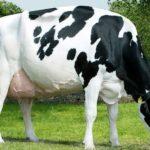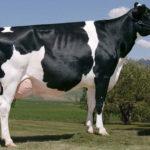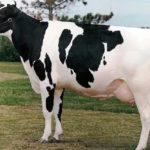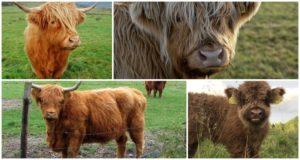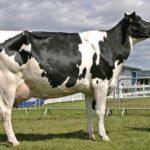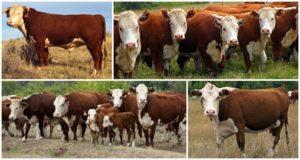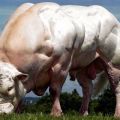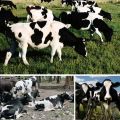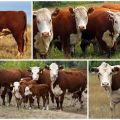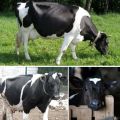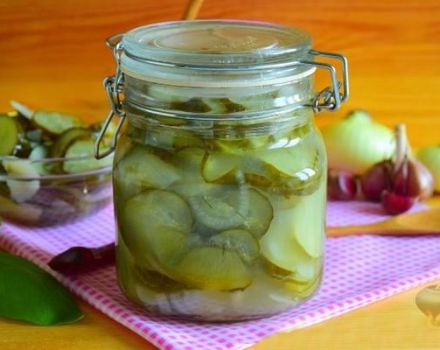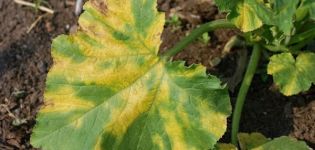Description and characteristics of Holstein cows, their pros and cons and care
Among the many western breeds, the Holstein is one of the best in milk yield and meat productivity. Holstein cows are appreciated by farmers all over the world for high-quality milk, record daily milk yield, and good health. However, Holsteins are capricious in their care, the well-being of the animals deteriorates, and milk production significantly decreases when the owner does not comply with the conditions of detention.
History and description
Holstein is a cattle breed of Dutch origin. It appeared in 1852. The American breeder Winnsrop Chenery was engaged in the breeding and distribution of the breed; in the United States, Dutch cows are most widespread. Initially, the breed was called the Holstein-Friesian, its representatives had an exclusively black and white spotted color, over time, red and white individuals appeared. Since 1983, the breed has been called simplistically - Holstein.
In America, breeding activities have been and continue to be carried out aimed at improving both the dairy and meat productivity of Holstein. Breeders are working to enlarge the physique of animals, hoping to increase milk yield.
The external breed characteristics of Holstein are given in the table.
| Height at withers | Females - 142-145 cm, males - 150-160 cm |
| weight | females - 650-750 kg, males - 1000-1200 kg |
| head | large, classic shape, on the tendon neck |
| torso | elongated, close to a triangular shape when viewed from the side, lean, with underdeveloped muscles and a thin skeleton, chest narrow, deep |
| horns | short |
| limbs | long, with developed joints and a wide set, high hooves |
| wool | short |
| color | black and white, spotted, less often red & white |
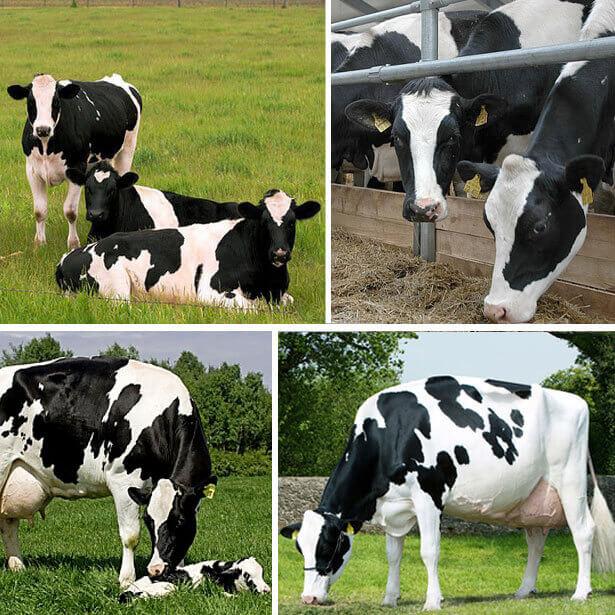
Characteristics of the Holstein breed
Holsteinized black-and-white breed belongs to the dairy type, but is characterized by good meat production. The Holstein-Friesian breed is extremely susceptible to the quality of keeping and feeding. Milk production depends on these factors. Milk yield is also influenced by climatic conditions. The milder and warmer the climate, the more productive the cows are.
On average, cows produce 8,500 liters of milk per year with a milk fat content of up to 3.7%. In Israel, the annual milk yield in large farms reaches 10 thousand liters, in the USA - 9 thousand, in Russia it does not exceed 7.5 thousand. In a private farm, 6-7 thousand liters are received from a cow per year.
Holstein cows are suitable for both hand milking and milking machines. The peculiarity of the productivity of the breed is that black and white cows, on average, give 2 times more milk than red relatives. The annual productivity of red cats does not exceed 4500 liters.
Slaughter weight reaches 55% of the body weight of the bull. Newborn calves weigh 35-45 kg.By the age of one year, with proper care and feeding, the bull reaches a weight of 800 kg. It is unprofitable to keep the animal further. If the bull is not intended for breeding activities, then it is sent to slaughter. Holstein bulls are often crossed with cows of other breeds to obtain offspring with increased productivity.
Advantages and disadvantages
Subtleties of maintenance and care
Holstein cows should not be in close quarters and in a sedentary state. For cattle, it is necessary to organize a walking area. Walking daily improves metabolism and digestion, which has a positive effect on the amount of milk produced.
The size of the walking area is made so that the individual has 20 m2... A canopy is erected over the site to protect animals from the scorching sun and precipitation. Drinking bowls must be installed, in which there must always be water. They walk the cattle every day for 2-3 hours, but only when there is no thunderstorm, strong wind or ice. Pregnant females are not released 3 days before calving.
A wooden shed is undesirable, it is better to make it out of brick. Holstein cows need to be warm and comfortable. In winter, insulation is required, since the productivity of livestock is significantly reduced from the cold, and additional lighting is also installed.
A suitable temperature in the stable is between +5 and +20 ° C. The temperature for adult animals must not rise to +23 ° C, for calves - up to +27 ° C. At temperatures below +5 ° C, the Holstein cow becomes unproductive. The optimum air humidity is 60-70%. The barn should be ventilated, but drafts are unacceptable, because of them cows get sick with mastitis.

One cow in the barn should have 20 m2, for a calf - 10 m2... The animals are not tied, they either move freely, or are kept in spacious stalls equipped with feeders and drinkers. For bedding, they take straw, make a layer of 20 cm on the floor. To maintain cleanliness, you can equip the barn with a sewer drain. Then the floor must be laid at a slight angle.
The barn must always be clean. The litter must be changed as it decays. Remove manure 2 times a day. Wash feeders and drinkers daily. The farmer should do a general cleaning twice a year using disinfectants.
Diet
Holstein cows are extremely picky about the diet. Therefore, their content in the Siberian and northern regions of Russia usually turns into a failure. In the summer months, animals are fed 2 times a day when there is a lack of pasture. In the winter months, cows are fed 3 times a day. The summer diet is based on green forage, in which the protein concentration is not less than 20% of the mass. The composition must necessarily contain leguminous fodder herbs:
- clover;
- lupine;
- peas;
- alfalfa.
The winter diet is based on hay, corn, legumes and grain feed, and meal. The feed must be of high quality. Rough feed should be 37%, juicy - 35%, concentrated - 28%. The amount of dry matter is 5 kg per 100 kg of the cow's body weight.
An approximate daily menu for an adult Holstein cow in winter:
- hay - 7 kg;
- haylage - 3 kg;
- straw - 3 kg;
- corn silage - 15 kg;
- root vegetables and vegetables - 5 kg;
- concentrates - 3 kg;
- salt - 100 g.
A cow drinks 50 liters of water per day, more during the lactation period. Water is given warm, heated to a comfortable temperature.
Breeding cows
When breeding, mainly the breed characteristics of bulls are taken into account, since the genes responsible for milk production are inherited from the father. Holstein breeding bulls are carriers of excellent genetic material, they are crossed with cows of other breeds in order to increase the milk production of the latter.

The Holstein breed is not fertile, cows bring no more than 3 calves in a lifetime. The generic process usually proceeds without complications. Newborn calves look strong, stocky, rise quickly, and follow their mother.
Calves are as capricious in grooming as adults. Before calving, the stall must be thoroughly cleaned and disinfected. The room needs to maintain the optimum temperature and humidity.
The newborn Holstein calf is susceptible to infection, so the farmer should not touch the calf with unwashed hands.
Diseases
Holsteins are distinguished by good health and physical activity, but only with the right care and maintenance. If hygiene standards are not observed in the stable, Holstein pets are affected by infectious diseases. Most often, necrobacteriosis (hoof rot) and leptospirosis (water fever) - a bacterial infection that affects the internal organs of the cow. Treatment is with antibiotics.
Mastitis develops in cattle due to drafts and cold. Due to stress, milk disappears, so you should not transport animals without special need, make noise near the barn. Holstein is a breed that is in great demand on all continents. The popularity of the breed is due to its high milk production and good meat production. But the breeding of Holstein cattle remains profitable only when maintaining optimal conditions for keeping animals.
